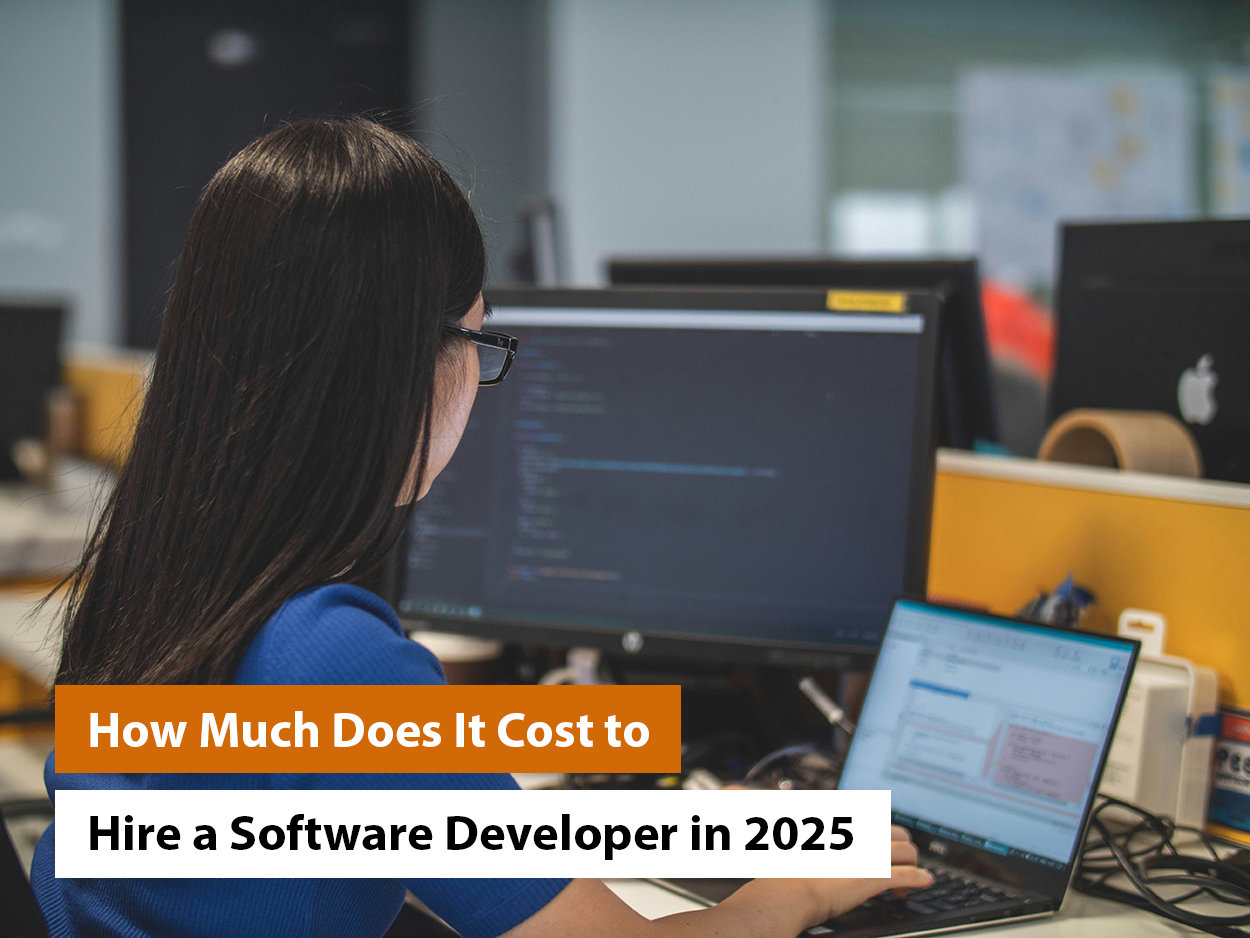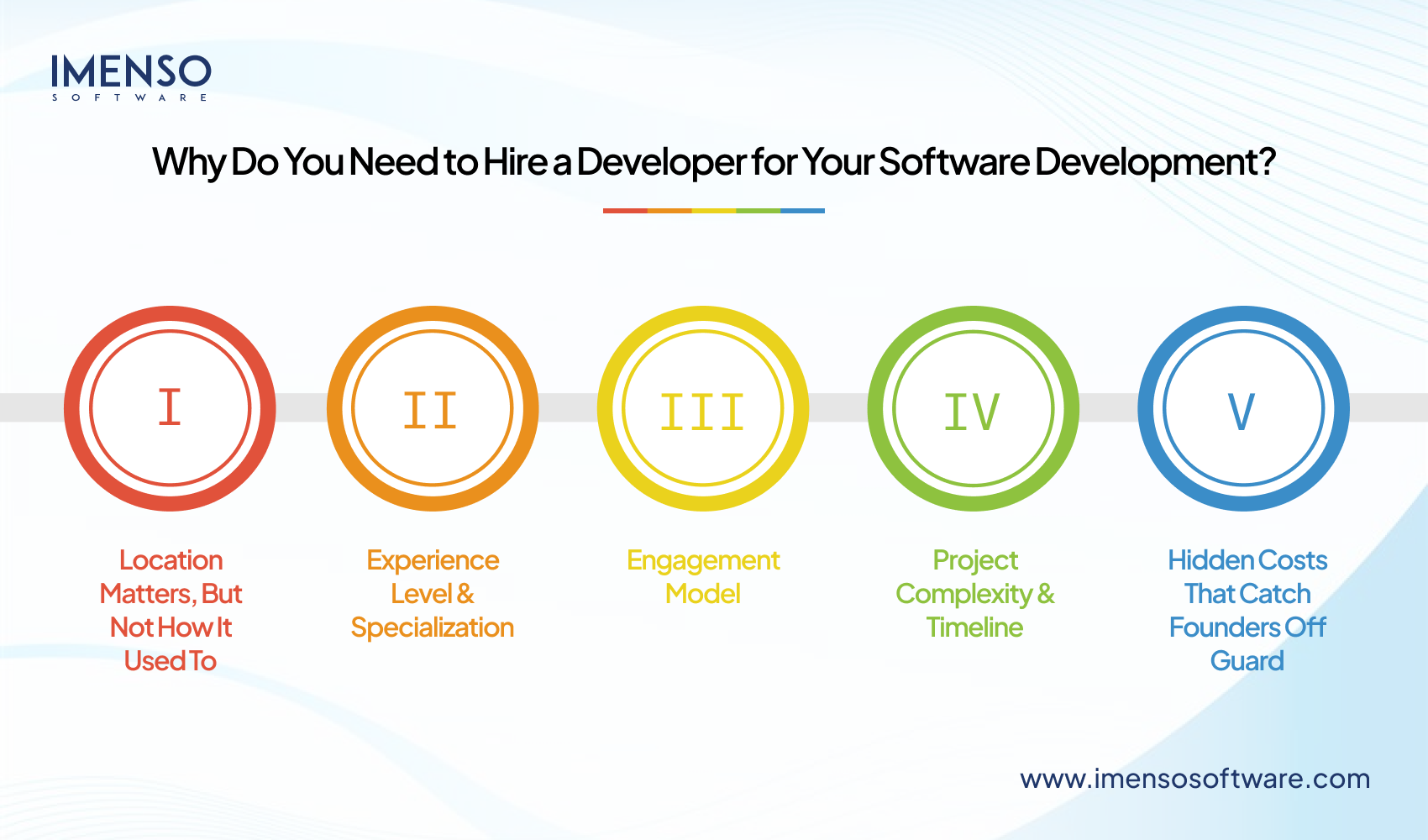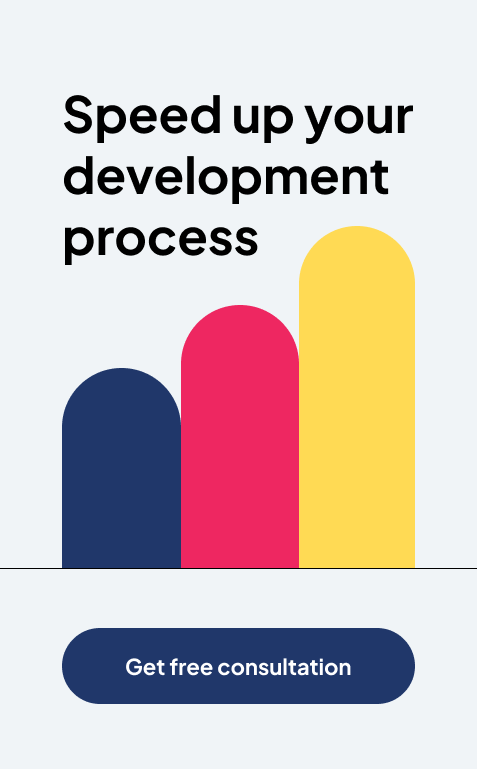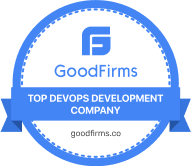How Much Does It Cost to Hire a Software Developer in 2025?

Expecting to bring an innovative and competitive idea to life via stunning software in 2025? But, estimating how much it costs to hire a software developer. Well, it involves lots of brainstorming, for instance:
- What exactly do you want to build, and how complex is it?
- Whether to hire in-house, outsource, or go hybrid.
- Developer rates across different regions and experience levels.
- Hidden costs like communication gaps, time zones, or misaligned expectations.
Plus, the other elements, such as comparing in-house and outsourced engagement models, researching rates across different regions, and navigating the reasons for budget overruns, need to be addressed.
You can’t manage what you don’t measure. – Peter Drucker
Know this: the average cost to hire a full-time software developer in the U.S. is $105,000–$130,000 annually. While offshore developers can cost as little as $20 per hour.
But lower rates don’t always mean lower costs in the long run. And, yes, it is necessary to develop a clarity about it.
Let’s break it all down so you can hire smart and build with confidence, without draining your budget.
Why You Need to Know How Much It Costs to Hire a Software Developer?
It is necessary to be informed about the developmental costs for a successful software initiative, irrespective of whether you are going to work with an individual team, doing it in-house, or outsourcing it. Because it has the potential to make or break your budget.
Whether you are a startup or an established enterprise, knowing this would ease the process of figuring out the cost of hiring a software developer for your project. Also, the rates change from region to region, experience, expertise, mode of working process, project complexity, and much more. So, these will be the driving factors for your software development costs.
Also, you will be able to maximize ROI on your software! Isn’t it interesting?
Why Do You Need to Hire a Developer for Your Software Development?
The market is very competitive. You need consistent support from experienced expert(s) who can assure you of unmatched quality and reliable maintenance of your bespoke solutions to thrive in this world. Onboarding skilled individuals ensures well-maintained software development procedures.
The total cost of hiring a developer is influenced by multiple factors that go beyond salary or hourly rate.
Here’s a closer look at the real cost drivers:

- Location Matters, But Not How It Used To
- Developers in North America and Western Europe remain the most expensive.
- But offshore talent in regions like Eastern Europe, Latin America, and Southeast Asia is catching up.
- Time zone overlap, communication, and productivity now matter as much as base cost.
Example: A U.S.-based React developer may charge $50–$150/hr. A top-tier dev in Poland or Brazil? $30–$60/hr with near-similar quality if managed well.
- Experience Level & Specialization
- Junior devs are cheaper but need mentorship.
- Mid-level devs offer a balance in cost and capability.
- Senior devs and specialists (AI, DevOps, Blockchain) can double or triple standard rates.
Insight: Hiring a $150/hr senior who completes tasks twice as fast can save more than hiring a $30/hr junior who struggles.
- Engagement Model
| Engagement Model | Considerations | |
| a. | In-house | High cost, but more control. Add 20–30% for benefits, tools, and overhead |
| b. | Freelancers | Flexible and fast to hire, but riskier for long-term or complex projects |
| c. | Agencies | Great for full-service builds. Costs more per hour but includes project management, QA, and more. |
| d. | Hybrid Teams | Mix local leads with offshore execution, ideal for scaling smart. |
- Project Complexity & Timeline
- A basic landing page costs far less than a scalable SaaS or enterprise tool.
- Urgent timelines can increase costs by 25–50% due to overtime or premium rates.
- Integration with APIs, AI components, or legacy systems means more money.
- Hidden Costs That Catch Founders Off Guard
| Type | Considerations | |
| a. | Onboarding Time | New hires can take 2–4 weeks to become productive. |
| b. | Tooling & Licensing | IDEs, dev environments, and project tools all add up. |
| c. | Team Management | Time spent coordinating means an increase in cost. Especially in remote settings |
| 💡 Pro Tip: Always budget 15–20% more than quoted. Most founders underestimate project pivots, bugs, or rework needs. |
What It Costs – Based on How and What You Build?
Hiring a developer is like ordering a custom cake; you don’t pay the same for a cupcake as you do for a five-tier wedding showpiece. The same rule applies to software projects.
Whether you’re hiring a solo freelancer for a one-page MVP or building a complex AI system with a dedicated team, your cost will vary dramatically based on:
- The engagement model (in-house, freelance, agency, offshore)
- The scope and complexity of your project
- The location and experience of your developers
And here’s the kicker:
Around 45% of startups go over budget on software development by 20–60%.
So let’s break down what you can expect to spend in different scenarios and how to avoid blowing your budget.
What Does It Typically Cost With an Engagement Model & Project Type?
Let’s bust a myth right now: there’s no one-size-fits-all price tag for hiring a software developer. It’s not just about the hourly rate; it’s about who you hire, how you hire them, and what you’re building.
Whether you’re launching a lean MVP, a full-scale SaaS, or an AI-powered platform, your hiring model and project scope will drive the cost. And in 2025, the gap between a budget build and a premium-grade solution is wider than ever.
Let’s break it all down so you don’t make the same mistake.
a. By Engagement Model
| Hiring Model | Avg.. Cost (Hourly) | Best For | Considerations |
| In-House | $65–$150/hr | Long-term, core team roles | Add 20–30% for benefits, payroll, and taxes |
| Freelancer | $30–$100/hr | Short-term projects, quick feature builds | Vet thoroughly; quality varies |
| Agency | $80–$200/hr | Full-service delivery with PM, QA | More expensive, but lower risk |
| Offshore Team | $25–$60/hr | Budget-friendly MVPs, scaling fast | Time zone and cultural gaps need managing |
| Hybrid | Varies | Blending quality with savings | Local strategy, offshore execution wins on cost & quality |
By Project Type
Let’s look at what specific builds might cost from end to end:
MVP for a SaaS Platform
- Freelancer team or offshore agency: $25K–$50K
- In-house team or premium agency: $80K–$150K+
Custom Mobile App (iOS + Android)
- Basic (3–6 screens): $20K–$40K
- Mid-level app with API integration: $40K–$100K
- Advanced (AI, AR, or real-time features): $100K–$250K+
Internal CRM/ERP Tool
- Freelancers/contractors: $30K–$60K
- Full-service agency: $70K–$200K
AI-Powered Application
- Prototype: $35K–$60K
- Scalable version: $100K–$300K+
Note: AI, DevOps, and blockchain-based projects cost significantly more due to limited talent and higher skill thresholds.
| Reality Check: According to CMARIX, most businesses underestimate final project costs by 20–35% due to scope creep and poor planning. |
| Smart Tip: Agencies often appear expensive, but they include project managers, QA testers, and UI/UX experts—so you’re buying a team, not just a coder. |
Real Startup Case Studies – What Founders Paid and Why
Reading rate cards is one thing; seeing what real startups spent (and how it played out) is another. These stories reveal the hidden costs, clever trade-offs, and smart decisions made by founders just like you.
- Bootstrapping a SaaS MVP on a Budget – And Scaling Later
- Startup: A B2B SaaS productivity tool
- Team Hired: Freelancers in Eastern Europe
- Initial Cost: $28,000
- Scope: Login, dashboard, basic analytics, and billing
- Challenge: Couldn’t scale the architecture after 6 months
- Final Cost (after rebuild): $90,000
- Lesson: “Building fast is good, but planning for growth is better.”
| Pro Tip: Use freelancers for MVP validation, but re-architect early if you’re seeing traction. |
- In-House vs. Offshore – Two Paths, Two Price Tags
- Startup: Fintech platform for microloans
- Scenario: Compared quotes from a US in-house team vs. a hybrid agency (US + India)
- In-House Estimate: $180,000
- Hybrid Delivery Cost: $78,000
- Outcome: Delivered faster, with 30% of the budget
- Lesson: With the right offshore partner, you can reduce costs without compromising on quality.
Smart Move: The founder kept product management onshore but outsourced engineering.
- Paying Premium for Product-Market Fit – And It Paid Off
- Startup: Healthtech mobile app with AI symptom checker
- Team: Niche AI/ML experts + a top-tier UX agency
- Cost: $220,000
- Result: Got acquired within 14 months
- Lesson: Sometimes, spending more on expertise leads to 10x outcomes.
Insight: Agencies with healthcare compliance experience saved months on regulation hurdles.
- Cheap Build, Expensive Fix
- Startup: E-commerce tool with custom API integrations
- Cost-cutting route: Hired the lowest-bid freelancers
- Initial Cost: $15,000
- Hidden Cost: Bugs, poor documentation, and rewrites
- Final Cost: $65,000
- Lesson: You pay either up front or in rework. There’s no shortcut to well-built software.
Real-world cost isn’t just what you pay, it’s what you get back. The smartest founders balance budget, quality, and scalability.
Real Startup Case Studies – What Founders Paid and Why?
The best way to understand software development costs? See what real startups spent, what they got, and what they learned. These true stories highlight the decisions founders made, how they impacted their budgets, and what they’d do differently.
1. Bootstrapped MVP – Great Start, Painful Rebuild
A B2B SaaS startup wanted to quickly validate their idea. They hired a few freelancers from Eastern Europe and launched a functional MVP in just 4 months for around $28,000.
At first, things went great, early traction, good UX. But when the app started scaling, they ran into performance issues and a weak backend architecture. Eventually, they had to rebuild the entire platform with a U.S. agency, spending an additional $90,000.
Lesson: MVPs should be lean, but not sloppy. If your idea grows fast, poor architecture will become your most expensive bottleneck.
2. Smart Hybrid Model – High Impact, Low Spend
A fintech startup building a mobile lending app got two quotes:
- A full U.S. in-house team: $180,000
- A hybrid model (U.S. product manager & Indian devs): $78,000
They chose the hybrid route, allowing them to maintain strategic oversight while leveraging the offshore engineering talent. The project launched successfully, on time and within budget.
Lesson: If managed well, hybrid teams can save you more than 50% without sacrificing control or quality.
3. Premium Build for a Big Payoff
A healthtech startup with a bold idea—an AI-based symptom checker, wanted flawless UX and strict compliance. They partnered with a U.S.-based design agency and hired top AI/ML experts.
Their cost? $220,000.
But their payoff was huge. Within 14 months, they gained market traction, secured user trust, and got acquired by a larger health company.
Lesson: Sometimes, high-quality development is your shortcut to ROI, especially in regulated or trust-sensitive industries.
4. The $15K App That Cost $65K
This startup built an e-commerce plugin with complex API integrations using the cheapest developers they could find on Upwork. The initial build cost just $15,000, but came with major problems: bad code, lack of documentation, and constant bugs.
Eventually, they scrapped the project and hired a proper dev team, spending more than $50,000 just to rebuild what they already had.
Lesson: Going cheap may work for landing pages, but not for full apps. Technical debt can be more expensive than you think.What you spend vs. what you gain depends on the choices you make around hiring, tech architecture, and long-term planning. Cost is never just about dollars; it’s about value, vision, and scalability.
Key Factors That Influence Developer Costs in 2025
Hiring a developer isn’t just about asking, “What’s your hourly rate?” The real cost of software development is shaped by multiple factors—some obvious, others often overlooked. If you want to avoid unexpected budget bloat, here’s what you need to consider:-
-
Project Complexity
The more complex your product is (AI, real-time features, integrations), the more it’ll cost.
- Simple App: Static content, basic features – lower cost
- Complex App: Custom algorithms, heavy backend logic – higher dev hours + testing
| Tip: Break down your features into “must-have” vs “nice-to-have” to control scope and cost. |
-
Developer Location
Rates vary drastically by region:
- US, Canada, Western Europe: $70–$200/hr
- Eastern Europe, Latin America: $30–$75/hr
But cheaper isn’t always better. You have to balance cost, communication, and quality.
-
Experience & Specialization
- Junior devs may charge less but need more handholding.
- Senior devs and specialists (e.g., AI/ML, blockchain) cost more but deliver faster and cleaner.
Pro insight: Paying $100/hr for an expert who finishes in 10 hours is cheaper than paying $40/hr for someone who takes 40 hours.
-
Tech Stack
Some languages and frameworks are more expensive due to supply and demand.
- Popular (React, Node.js): More affordable talent pool
- Niche (Rust, Elixir, Go, SwiftUI): Fewer devs = higher rates
-
Engagement Model
- Hourly: Good for short-term or evolving scope
- Fixed-price: Better for well-defined projects
- Dedicated team: Ideal for long-term development
Each model affects not just the cost, but also how flexible and fast your development process can be.
-
Testing & QA Requirements
If your app needs to be bug-free from day one (healthcare, fintech, e-commerce), budget for strong QA.
- Manual + automated testing can add 15–25% to your cost, but save thousands in damage control later.
-
Architecture & Scalability
Do you need something quick and dirty for MVP, or a long-term, scalable architecture?
- MVPs are cheaper but often need rebuilding
- Scalable systems take longer, but future-proof your app
Case in Point: Airbnb rebuilt its original stack 3 times before hitting full scale.
-
Security & Compliance
If you’re handling payments, healthcare data, or personal information, you’ll need encryption, secure databases, and possibly GDPR or HIPAA compliance. This adds complexity and cost.
-
Ongoing Maintenance
Development doesn’t stop at launch. You’ll need bug fixes, updates, scaling, and customer feedback loops.
Factor in 10–20% of your annual dev budget for maintenance.
The true cost of hiring a software developer in 2025 depends on far more than just location or role. It’s a cocktail of complexity, tech choices, and long-term thinking.
How to Reduce Developer Hiring Costs Without Compromising Quality?
Hiring top developers doesn’t have to drain your budget if you’re strategic. You don’t need to pick the cheapest option; you just need to optimize for value. Here’s how to keep costs in check without sacrificing quality:
-
Start with a Clear Scope
The biggest cost-killer? Vague requirements. A fuzzy project scope leads to scope creep, missed deadlines, and wasted hours.
| Tip: Build a Product Requirement Document (PRD) before hiring. Use tools like Notion or Trello to map features, flows, and user stories. |
-
Validate Before You Build
Why spend $100K on something no one wants? Start with wireframes or a clickable prototype. Tools like Figma or Framer can help you gather early feedback, before any code is written.
-
Use Open-Source Tools & Frameworks
Don’t reinvent the wheel. Use existing libraries, SDKs, and platforms to accelerate development.
- Firebase for backend
- Stripe for payments
- Auth0 for user authentication
- Tailwind CSS for UI
These tools cut dev time, which means lower bills.
-
Choose a Cost-Efficient Region Wisely
Offshoring doesn’t mean compromising quality if you research properly.
- Eastern Europe: Great balance of price and technical expertise
- India: Massive talent pool, especially for scalable builds
- Latin America: Close time zones to North America
| Pro tip: Combine offshore devs with a local PM or tech lead for better control. |
-
Hire for Skill, Not Just Resume
A senior dev might cost more upfront, but will finish faster, write cleaner code, and need less supervision. One good dev can replace three average ones. Time is money, especially in software.
-
Leverage Low-Code/No-Code Tools for MVPs
Platforms like Bubble, OutSystems, and Glide let you launch basic versions without heavy development.
- Great for testing
- Cuts down initial dev spend by 60–70%
Once validated, you can scale with full code.
-
Choose the Right Engagement Model
- Fixed price for defined scope.
- Hourly for evolving needs.
- Dedicated team for full-product builds.
Mix and match models to balance cost with flexibility.
-
Use DevOps & Automation
Continuous Integration, automated testing, and cloud deployment tools save time and prevent costly bugs.
Think: GitHub Actions, Docker, AWS, Postman
Smart planning, efficient tools, and choosing the right hiring model can slash costs without compromising quality or speed.
Consider A Quick Cost Estimation Guide
Hiring a software developer in 2025 isn’t just about how much you spend, it’s about how smartly you spend. Whether you’re building a sleek mobile app, a complex SaaS platform, or an AI-powered tool, knowing what influences development costs gives you the power to plan, prioritize, and avoid financial surprises.
Let’s tie it all together with a simple cheat sheet:
Quick Cost Estimation Breakdown (2025)
| Project Type | Estimated Cost | |
| 1. | Basic Website / Landing Page | $3,000 – $10,000 |
| 2. | MVP for Mobile or Web App | $10,000 – $50,000 |
| 3. | Full SaaS Platform | $50,000 – $250,000+ |
| 4. | AI/Data-Heavy App | $80,000 – $300,000+ |
| 5. | Maintenance & Upgrades | 15–25% of dev cost annually |
Pro Tips to Get It Right
- Write clear requirements before hiring
- Vet developers with portfolio & code samples
- Test communication with a short paid task
- Track time & tasks using agile tools (Jira, ClickUp)
The software world moves fast. Hiring the right developer, in the right way, at the right cost can mean the difference between a launchpad and a money pit. Take your time, plan smartly, and don’t just focus on saving money & focus on investing in value.
Frequently Asked Questions (FAQs)
- What is the average hourly rate to hire a software developer in 2025?
Rates vary based on location and experience:
- US & Canada: $80–$200/hr
- Eastern Europe: $40–$80/hr
- India & Southeast Asia: $20–$50/hr
- How much does it cost to build a basic MVP?
A simple MVP typically costs between $10,000 and $50,000, depending on the features, design complexity, and whether you use freelancers, agencies, or in-house developers.
- What’s cheaper: Hiring in-house or outsourcing?
Outsourcing is generally 40–60% more cost-effective than hiring in-house, especially when you consider salaries, benefits, tools, and workspace overhead.
- How do I ensure quality if I’m hiring offshore?
- Work with trusted platforms (like Toptal, Upwork, or vetted agencies)
- Start with a paid test project
- Use clear documentation and project management tools
- Consider hiring a local project manager or tech lead
- Can I reduce costs with low-code or no-code tools?
Yes! Platforms like Bubble, Glide, or Webflow allow you to build and test MVPs at a fraction of the cost of traditional development.
- What hidden costs should I watch out for?
- Project scope creep
- Delayed timelines
- Post-launch maintenance
- Tool licenses or APIs
- Security or compliance add-ons
- How do I estimate a realistic budget for my app?
Start with clear goals, define must-have features, consult 2–3 developers or agencies for quotes, and always keep a 15–20% buffer for surprises.
Want more information about our services?
Similar Posts

A Comprehensive Guide to Embedded Software Development for Businesses
In an increasingly interconnected world, businesses across various industries rely on embedded systems to power their products and services. Embedded software development is a specialized field that creates software solutions tailored for these systems. In this comprehensive guide, we will explore what embedded software development entails, highlight the reasons for businesses to invest in it, […]...

10 Essential Features to Include in Your Custom CMS Development
Content Management Systems (CMS) have revolutionized the way websites are built, managed, and updated. While there are numerous off-the-shelf CMS platforms available, there are cases where a custom CMS development is the better choice. Custom CMS development empowers businesses to tailor the system to their specific needs, resulting in enhanced control, performance, and user experience. […]...

NodeJS Security: Best Practices for Keeping Your Application Safe from Threats
Are you concerned about the security of your Node.js application? Are you aware of the potential risks and vulnerabilities it may face in today’s ever-evolving threat landscape? Protecting your application from malicious attacks and unauthorized access is crucial to safeguarding sensitive data and maintaining user trust. But where do you begin? In a world where […]...









